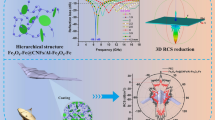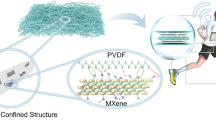Abstract
We have studied the influence of the connectivity pattern, the nature of the piezoelectric material, and rod thickness on the properties of magnetoelectric composites with the composition 50 vol % PZT/50 vol % NiCo0.02Cu0.02Mn0.1Fe1.8O4 − δ (where PZT stands for various commercially available lead zirconate titanate based piezoelectric materials). The results indicate that the magnetoelectric conversion efficiency of the rod composites with any connectivity pattern (1-1, 1-3, or 3-1) is 10–20% higher than that of laminate composites. The largest magnetoelectric conversion coefficient ΔE/ΔH is offered by the 1-1 connectivity composites. The ΔE/ΔH of the composites correlates with both their piezoelectric sensitivity g 33 and the piezoelectric sensitivity of the corresponding piezoelectric materials. ΔE/ΔH is shown to be inversely proportional to the thickness of the piezoelectric and ferrite rods. The highest ΔE/ΔH at a frequency of 1 kHz, 450 mV/(cm Oe), has been reached in the PZT-36 based composites with 1-1 connectivity and 0.3-mm-thick rods.
Similar content being viewed by others
References
Van den Boomgaard, J., Terrel, D.R., Born, R.A.J., and Giller, H.F.J.I., An in situ grown eutectic composite material. Part 1–2, J. Mater. Sci., 1974, vol. 9, no. 10, pp. 1705–1714.
Lupeiko, T.G., Lisnevskaya, I.V., Lopatin, S.S., and Zvyagintsev, B.I., Magnetoelectric composite materials based on lead zirconate titanate and nickel ferrite, Inorg. Mater., 1994, vol. 30, no. 11, pp. 1353–1356.
Lupeiko, T.G., Lisnevskaya, I.V., Chkheidze, M.D., and Zvyagintsev, B.I., Laminated magnetoelectric composites based on nickel ferrite and PZT Materials, Inorg. Mater., 1995, vol. 31, no. 9, pp. 1139–1142.
Lisnevskaya, I.V. and Lupeiko, T.G., PZT-NiCo0.02Cu0.02Mn0.1Fe1.8O4 − δ magnetoelectric rod composites with 1-3, 3-1, and 1-1 connectivity, Inorg. Mater., 2012, vol. 48, no. 4, pp. 410–415.
Bracke, L.P.M. and Vliet, R.G., A broadband magnetoelectric transducer using a composite material, Int. J. Electron., 1981, vol. 51, no. 3, pp. 255–262.
Smith, W.A., Modeling 1–3 composite piezoelectrics: thickness-mode oscillations, IEEE Trans. Ultrason. Ferroelectr. Freq. Contr., 1991, vol. 38, no. 1, p. 40.
Petrov, V.M., Magnetoelectric susceptibility of a multilayer ferrite-piezoelectric composite, Vestn. Novgorod. Gos. Univ., 2004, no. 26, pp. 19–23.
Author information
Authors and Affiliations
Corresponding author
Additional information
Original Russian Text © I.V. Lisnevskaya, T.G. Lupeiko, N.G. Lagunova, 2014, published in Neorganicheskie Materialy, 2014, Vol. 50, No. 7, pp. 778–783.
Rights and permissions
About this article
Cite this article
Lisnevskaya, I.V., Lupeiko, T.G. & Lagunova, N.G. Influence of the connectivity pattern, the nature of the piezoelectric material, and rod thickness on the properties of 50 vol % PZT/50 vol % NiCo0.02Cu0.02Mn0.1Fe1.8O4 − δ magnetoelectric composites. Inorg Mater 50, 723–727 (2014). https://doi.org/10.1134/S0020168514070085
Received:
Published:
Issue Date:
DOI: https://doi.org/10.1134/S0020168514070085




